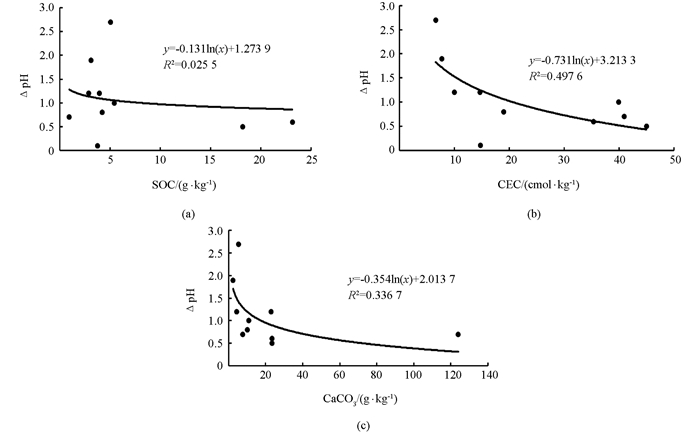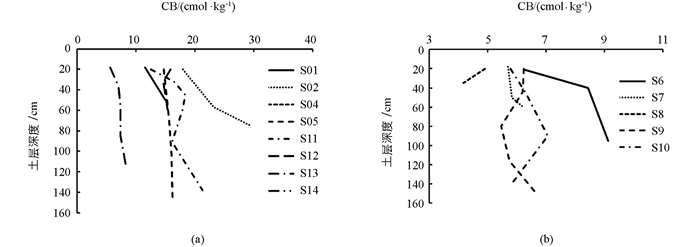-
酸度是土壤重要的化学特征之一,控制着土壤中许多重要的物理、化学及生物过程,进而影响土壤在生态系统中的功能,酸化也是土壤发生发展中重要的自然过程[1].土壤过酸可能会造成营养物质流失、有毒金属活化、农作物减产等一系列负面影响,对我国农业生产与环境安全构成了巨大的潜在威胁[1],同时也会造成铝、锰和氢对植物的毒害以及土壤中营养元素P,Mo,Ca,Mg的缺乏,从而使作物减产[2-3];且土壤过酸不仅会影响农业和生态环境,更重要的是受它影响的土地面积及它对农业和环境的影响程度都将随时间的增加而增加[4].紫色土是重庆市分布面积最广的旱地土类,总面积约2.74×106 hm2,占全市土地总面积的33.22%,包括酸性紫色土、中性紫色土和石灰性紫色土3个亚类.在现行的发生分类体系中,酸性紫色土包括夹关组(K2j)母岩发育的红紫泥土和因淋溶脱钙而形成的酸紫泥土两个土属.近期,笔者调查发现重庆江津低海拔区域存在一类由沙溪庙组(J2s)母岩风化发育的酸性紫色土,其酸性成因并非淋溶脱钙.上述情况使得现行的酸性紫色土土属划分不能满足新的土壤调查需要.
迄今为止,前人对土壤酸度的研究主要集中在耕作制度[5-9]、施肥活动[4]和酸沉降[10]等的影响,而对其发育过程中土壤酸度的变化研究甚少,酸度形成机制的研究将对预防土壤酸化、改良土壤酸碱性和提高土壤生产性能等具有重要价值.因此,本研究主要从成土因素的角度出发,探讨土壤酸度的来源,并按其酸性成因的不同重新定义一部分酸性紫色土在发生分类中的位置,以完善重庆市土壤发生分类体系,在定量化、标准化和规范化的系统分类快速发展的今天,土壤发生分类的发展和完善仍很有必要,其对于如何改良土壤、如何提高农田生产效率和改良土壤等问题具有一定的参考价值.
全文HTML
-
重庆市地处我国西南,位于105°11′-110°11′E,28°10′-32°13′N之间,总面积约为8.24×104 km2,属亚热带湿润季风气候,冬暖夏热,年均温16~18 ℃,平均降水量较丰富,大部分地区在1 000~1 350 mm,降水多集中在5-9月份,占全年总降水量的70%左右,全市年平均相对湿度多在70%~80%,属于高湿区.年日照时数1 000~1 400 h,日照百分率为25%~35%,为中国年日照最少的地区之一,冬、春季日照更少,仅占全年日照的35%左右,无霜期340~350 d,气候垂直分布明显,因受地形影响,一般存在500~600 m和800 m左右2个逆温层,降水量随海拔增高而增多,多雨带各地不一.
-
2016年,在重庆市域范围内采集16个典型酸性紫色土剖面(表 1),其成土母岩类型为沙溪庙组(J2s)、蓬莱镇组(J3p)和夹关组(K2j)地层的紫色沉积岩.剖面挖掘后,按土壤发生层次采集样品,及时带回实验室风干、磨细过筛后待用.对剖面进行野外观测,判断土壤质地,并做石灰反应,测定其野外pH值和含水量,收集当地的气候数据,用GPS仪测定经纬度和海拔,用以分析成土环境.为便于后文表达,文中用J2s酸性紫色土、J3p酸性紫色土和K2j酸性紫色土分别表示J2s、J3p和K2j母岩发育的紫色土.
由表 1可知,供试土壤均分布在渝西地区,海拔范围254~1 027 m,其中J2s酸性紫色土主要分布在低海拔区域254~585 m,J3p酸性紫色土所处海拔较高,为613~874 m,K2j酸性紫色土所处海拔也较高,达500 m以上,海拔最高点1 027 m.成土母质类型为J2s发育的泥岩、砂质泥(页)岩、砂岩和泥(页)岩混合物风化残坡积物,J3p发育的泥岩、砂岩风化残坡积物以及K2j发育的砂岩和砂岩、泥(页)岩混合物风化残坡积物.土地利用方式以旱地为主,另外有1个果园和1个林地,人为活动较明显.
-
数据的测定和计算依据《土壤调查实验室分析方法》[11]和《土壤农化分析》[12]:土壤pH值(水提):电位法(水:土=2.5:1);有机碳(SOC):K2Cr2O7—硫酸硝化法;机械组成:吸管法;交换性酸(EA)/交换性氢(EH)/交换性铝(EAl):KCl交换-NaOH中和滴定法;交换性盐基(EB):NH4OAc交换;Ca,Mg:原子吸收光谱法;K,Na:火焰光度法;阳离子交换量(CEC):NH4OAc-EDTA交换法;碳酸盐质量分数(CaCO3):容量法.
-
用Excel 2016作图,用SPSS 19.0做方差分析和多元回归分析.
1.1. 研究区概况
1.2. 供试土壤
1.3. 分析项目和方法
1.4. 数据处理
-
由表 2可知,剖面S06,S08,S10,S15和S16的母岩(质)pH值分别为7.3,5.6,7.3,8.5和8.9,S15和S16达到强石灰性,S06和S10为中性,S08为酸性,B层pH值均为6.5以下,呈酸性,与母岩(质)pH值相比,降幅分别为20.78%,21.43%,17.81%,14.12%和31.46%,同时,由表 1可知,它们所处海拔较高,分别为688,1 027,613和874 m,均达到600 m以上,且地形较平坦,坡度起伏不大.而S14所处位置海拔为585 m,pH值降幅仅为9.68%,降低不明显,S14所处地形坡度较陡,地形为山地.
-
由表 2可知,J2s酸性紫色土的母岩(质)大部分为中性和酸性,包括1个石灰性(S03,pH值为8.5),J3p酸性紫色土的母岩(质)均为强石灰性,K2j酸性紫色土的母岩(质)基本都为酸性,只有S06和S10的母岩(质)pH值为7.3,呈中性. SOC,CEC和CaCO3含量均能表征土壤的缓冲性能,其值越高,土壤缓冲性能越强[13].为忽略人为活动对土壤酸化的影响,本研究用母岩(质)与B层pH值的差值(ΔpH)表示由自然因素所引起的土壤酸度变化,母岩(质)的SOC,CEC和CaCO3表示土壤自身的属性.如图 1,随着母岩(质)SOC,CEC和CaCO3值的增加,ΔpH均呈下降的趋势,回归拟合模型符合对数形式(其中p(CEC)<0.05,p(CaCO3)<0.05,p(SOC)>0.05),由斜率大小,这3种母岩特性对ΔpH的影响程度大小关系为CEC>CaCO3>SOC,CEC的影响程度最大,从拟合程度,CEC>CaCO3>SOC,CEC的拟合程度最好,综上所述,母岩(质)的CEC对ΔpH的影响程度最大,SOC对其几乎没有影响.
-
土壤质地的不同会影响淋溶效果,砂质土壤淋溶作用强,盐基离子的淋失严重,而黏质土壤的滞水作用导致淋溶作用偏弱.如表 2,供试土壤的土壤质地主要以壤土为主(包括粉壤土、砂质壤土、粉质黏壤土、砂质黏壤土和黏壤土),另外有1发生层次为黏土,3个为粉质黏土. J2s酸性紫色土粉粒质量分数普遍偏高,只有S03和S04的砂粒质量分数高于粉粒质量分数,J3p酸性紫色土的砂粒质量分数偏高,K2j酸性紫色土砂粒质量分数也较高,黏粒质量分数很低. S13的交换性酸(EA)质量摩尔浓度最高,全剖面EA质量摩尔浓度的范围为13.58~21.50 cmol/kg,母岩(质)EA质量摩尔浓度达到13.58 cmol/kg,其砂粒质量分数最低,为23.0~178.4 g/kg,黏粒质量分数最高,达到285.5~454.6 g/kg,土壤质地为粉质黏土和粉质黏壤土,质地黏重,所处海拔低(280 m);S09的EA质量摩尔浓度(8.27~8.96 cmol/kg)仅次于S13,黏粒质量分数最低,仅为2.1~2.4 g/kg,砂粒质量分数不高(324.2~409.6 g/kg),粉粒质量分数最高,为588.4~673.7 g/kg,海拔达到500 m以上;S16的EA质量摩尔浓度最低(0.17~0.92 cmol/kg),砂粒质量分数最高(622.0~754.7 g/kg),而黏粒质量分数较低(79.1~112.6 g/kg),所处海拔874 m;S10所处位置的海拔最高(1 027 m),砂粒质量分数较高,因此其EA质量摩尔浓度也较低(0.35~0.81 cmol/kg).
-
土壤表面吸附离子的构成比例不同,都将影响土壤的酸碱度,无论是J2s,J3p还是K2j酸性紫色土,均是Ca2+占优势,4种盐基离子质量分数的大小顺序为Ca2+>Mg2+>K+>Na+,且这个规律不受土壤母质类型和岩石地层的限制,只有S11的Na+>K+,土壤pH值与EB(cmol/kg)的正相关关系极有统计学意义(p<0.01).做pH值与Ca2+,Mg2+,K+,Na+饱和度(Ca2+,Mg2+,K+,Na+与CEC的比值,%)的多元回归分析,模拟一般回归方程为:pH=3.143+0.044Ca2+(%)+0.049Mg2+(%)-0.174K+(%)+0.021Na+(%)(p<0.01),其中Ca2+和Mg2+饱和度对pH值的影响极有统计学意义(p<0.01),K+和Na+则对pH值没有影响,对其进行逐步回归得多元回归方程:pH=3.084+0.043 Ca2+(%)+0.047 Mg2+(%)(p<0.01).
对于J2s酸性紫色土做pH值与Ca2+,Mg2+,K+,Na+饱和度的多元回归分析,直接进行逐步回归,得到多元回归方程:pH=3.550+0.036Ca2+(%)+0.032Mg2+(%)(p<0.01),只有Ca2+和Mg2+饱和度对pH值有影响,其中Ca2+饱和度极有统计学意义(p<0.01),而Mg2+饱和度有统计学意义(p<0.05),K+和Na+饱和度对J2s酸性紫色土的pH值没有影响.对K2j酸性紫色土同样做逐步回归,得到多元回归方程:pH=2.258+0.058Ca2+(%)+0.087Mg2+(%)-0.386K+(%)(p<0.01),Ca2+和Mg2+饱和度对pH值的影响极有统计学意义(p<0.01),K+饱和度对pH值的影响有统计学意义(p<0.05),无论是J2s还是K2j酸性紫色土,Na+饱和度对pH值均无影响.
EB质量摩尔浓度(cmol/kg)随着土壤深度增加的变化反映了淋溶作用的强弱,图 2(a)和(b)分别表示J2s酸性紫色土和K2j酸性紫色土EB质量摩尔浓度随土层深度的变化情况,总体上,随着土层深度的增加,EB质量摩尔浓度呈现上升的趋势,如图 2(a),J2s酸性紫色土EB质量摩尔浓度的变化程度较小,只有S02的变化幅度强烈,尤其当土壤深度达到57 cm以后,增幅变大. K2j酸性紫色土所有剖面EB质量摩尔浓度的变化幅度均较剧烈,其中S06的变化最明显,变化较剧烈的位置在上部土层(40 cm以上),下部趋缓,S08的EB质量摩尔浓度不增反减,S09先减后增,S10先增后减.
-
如表 2,剖面S07,S09和S13的pH值变化程度不明显,表层与底层仅相差0.1~0.2个单位,pH值的降低并不明显,而S01,S03和S15的酸度变化较大,表层pH值的降低很明显,由下表层的中性或微石灰性直接降低为酸性,其酸化主要发生在耕层土壤中.而其他剖面的酸度变化则是由底层到表层逐渐降低的,耕层土壤的pH值最低.本研究采集土壤的利用方式除S13是林地以外,其余均为旱地,受人为耕作影响较为强烈.
2.1. 海拔和地形对土壤酸度的影响
2.2. 母岩(质)对土壤酸度的影响
2.3. 机械组成与土壤酸度的关系
2.4. 交换性盐基对土壤pH值的影响
2.5. 人为因素对土壤酸度的影响
-
本研究主要探究土壤的成土条件、海拔、母岩(质)特性、土壤质地、EB质量摩尔浓度和种类以及人类活动等因素对酸度的影响,用母岩(质)与B层pH值的差值(ΔpH)来表征自然因素所导致的土壤酸度变化.供试土壤均采集自重庆市域范围内,总体来说气候差异不大,但是J2s,J3p和K2j这3个地层之间存在明显的海拔差异,J2s出露海拔较低,普遍位于600 m以下,大部分集中在300 m左右,J3p和K2j出露海拔较高,均位于500 m以上,因此,J2s酸性紫色土EB质量摩尔浓度随着土层深度的增加变化不明显,淋溶作用弱,母岩(质)理化性质对土壤酸度的影响程度更大,而J3p酸性紫色土由于所处海拔普遍较高,母岩(质)类型均为石灰性,海拔成为影响其酸性的最主要因素. S14发育自J2s母岩,其母岩(质)pH值为6.2,B层降幅9.68%,所处海拔较高(585 m),但其淋溶作用不明显,原因可能是因为该点坡度较陡,地表径流和土壤侵蚀作用导致该剖面的土壤一直处于初育状态,土体内部的淋溶作用较弱,因此该点的酸度变化不明显.
土壤质地的不同对酸度也有影响,S13的交换性酸质量摩尔浓度高,黏粒质量分数最高,砂粒质量分数最低,但是由于海拔也较低(280 m),淋溶作用弱,因此土壤质地对其酸性变化的影响不大,交换性酸质量摩尔浓度高的原因是由于母岩(质)本身交换性酸质量摩尔浓度较高,S09的交换性酸质量摩尔浓度仅次于S13,其黏粒质量分数最低,且海拔较高(588 m),降雨量丰富,土壤质地类型为粉壤土,增强了淋溶效果,所以该点交换性酸质量摩尔浓度较高是由海拔高、淋溶作用强所导致的. S16的交换性酸质量摩尔浓度最低,砂粒质量分数最高,海拔达到800 m以上,且母岩(质)呈石灰性,所以上层土壤呈酸性是由淋溶作用造成的,但该剖面母岩(质)呈强石灰性,使得其酸缓冲性较高,因此,海拔是土壤质地影响酸度的前提,只有当海拔达到一定的高度使降雨量增加,质地才会影响淋溶作用强度.
此外,供试土壤均存在一定程度的人为扰动,因此,人为因素也会影响土壤的酸度变化,其中,S01,S03和S15的表层pH值变化较大,亚表层为中性或微石灰性,表层则变为酸性,说明其受人为活动的影响较大.而S07,S09和S13全剖面的pH值的变化程度都不大,这可能是因为S09和S13母岩(质)的pH值已经较低,基本到达了土壤酸度的最低点,因此不会再发生酸度的变化,S07全剖面的pH值在5.0左右,并不是很低,这可能是因为该点的耕作强度较弱所致.且S04,S05,S11,S12和S13为J2s酸性紫色土,它们的母岩(质)本身呈酸性,在后期土壤的发育过程中,此类土壤必然呈酸性,说明该类土壤呈酸性是在成岩过程中所导致的.母岩(质)SOC,CEC和CaCO3含量都会影响ΔpH,呈负对数关系,这是因为SOC,CEC和CaCO3越高,土壤的缓冲性能越强,从而降低土壤的酸敏感度,其影响程度的大小关系为CEC>CaCO3>SOC,SOC的影响程度最小,可能是因为母岩(质)本身SOC质量分数较低,且SOC的主要来源是人为施肥,因此SOC质量分数高低的作用效果不大.
盐基离子的质量摩尔浓度和组成也会影响土壤的酸碱度,供试土壤4种盐基离子质量摩尔浓度的大小顺序为Ca2+>Mg2+>K+>Na+,pH值与EB(cmol/kg)之间的正相关关系极有统计学意义(p<0.01),其中Ca2+和Mg2+饱和度对pH值的影响的正相关极有统计学意义(p<0.01),而K+和Na+饱和度对pH值无影响,这与刘世全等[14]的研究结果不同,该研究显示,西藏酸性土壤的pH值仅与Ca2+离子饱和度的正相关极有统计学意义(p<0.01),而与Mg2+,K+和Na+离子饱和度没有相关性,这可能是由于供试土壤种类不同所导致的,对于J2s酸性紫色土,仅有Ca2+离子饱和度与pH值的正相关关系极有统计学意义(p<0.01),Mg2+离子饱和度对pH值的影响有统计学意义(p<0.05),K+和Na+离子饱和度则没有影响. K2j酸性紫色土为Ca2+和Mg2+离子饱和度对pH值的影响极有统计学意义(p<0.01),而K+离子饱和度有统计学意义(p<0.05),Na+饱和度依旧对pH值无影响,这说明对于不同岩石地层母质发育的土壤,不同盐基离子的饱和度对pH值的影响也不同,但无论对于何种类型的土壤,Ca2+离子饱和度对土壤pH值的影响总是占主导地位,而Na+离子饱和度则无影响.
-
紫色土的化学成分具有较强的稳定性[15],且不断得到母岩盐基物质的补充,其土壤性质与其母岩(质)之间有密切关系[16-21],对母岩有很大的继承性[22-23].供试土壤发育自3种岩石地层,其中,J3p酸性紫色土属于含钙母质在淋溶作用下发育的酸性紫色土,在土壤发生分类中归为酸紫泥土土属,K2j酸性紫色土属夹关组红色砂岩发育的酸性紫色土,归属于红紫泥土.由表 2可知,部分J2s酸性紫色土剖面通体呈酸性,如S04,S12,S13和S14,其母岩(质)也呈酸性,ΔpH依次为0.8,0.9,0.1和0.7,差值不大,均未超过1,且剖面整体上EB的变化范围也不大,淋溶作用较弱,说明这几个样点之所以呈酸性,是由酸性母岩(质)导致的.但是基于酸性紫色土亚类现行的划分标准,该类土壤在发生分类中没有相应的土属,这是由于酸性紫色土发生分类的划分原则是由母质类型和淋溶作用判断基层单元,再由pH值判断高级分类单元的划分顺序所决定的,这使得土属和亚类的划分之间存在一定的矛盾,导致该类沙溪庙组酸性母岩发育的紫色土在现有分类单元中没有相应的位置.
3.1. 重庆市酸性紫色土的成因分析
3.2. 酸性紫色土的成因及其对发生分类的影响
-
在重庆市内,成岩和成土两个过程均是影响酸性紫色土形成的关键环节,有一部分酸性紫色土是由酸性母岩直接风化发育形成;随着海拔的不断增加,土体内的淋溶脱钙作用不断增强,当海拔达到500 m以上,部分母岩为中性或钙质紫色岩的紫色土易发育为酸性紫色土.在划分酸性紫色土土属时,不能仅依据母岩类型和淋溶作用而定,而须遵守先确定亚类再划分土属的分类顺序;针对沙溪庙组酸性紫色岩发育的酸性紫色土在现行发生分类体系中缺少相应土属位置的问题,建议扩大酸紫泥土土属的涵盖范围或增设一个新的土属(建议名为原生酸紫泥土).




 下载:
下载:
